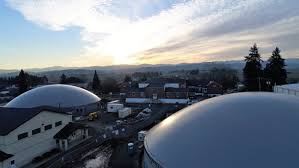Dome Construction Underway
Driving down the streets of Yamhill you may notice something new, a big grey bubble in between the intermediate school and high school. It’s the first out of two domes that will be going up during the bond construction.
You might have heard in the past week all the talk about the dome going up; it was scheduled to go up a recent Friday, then it changed to Saturday, then Tuesday, and it eventually went up on Wednesday January 10th . Turner Construction started to inflate it around 2:50 instead of the planned 2 o’clock. The final inflation took so long to happen for a multitude of reasons according to Turner Project Manager, Jonathan Morse. “ The single largest [concern] is worker safety, which takes priority over installation production. The water and mud around the site have made access tricky, so the work has been much slower (while maintaining safety standards) over the past week than crews expected,” says Morse. Some other requirements that need to be met before they start the inflation process are: there needed to be about three hours without rain so they could set up the industrial inflation fans, airlocks, power connections and avoid collecting more water on the roof membrane.
What benefits do domes have over traditional architecture? When asked why the school board picked domes Superintendent Charan Cline said “a community member sent me a video from a TV station in Utah about schools that were being built in Texas using concrete dome technology… I talked to the superintendent and director of maintenance at that school district and it was clear that they loved the building,” but that’s not all he had to say. He also mentioned how it would also cost less compared to traditional architecture; though not as inexpensive as they initially thought. The dome ended up costing about $286 per square foot compared to $325 for traditional architecture. Another big reason they chose domes was the fact they could model them so they could survive large natural disasters; they are only supposed to move about 1/8th inch in a 9.0 magnitude earthquake.
The biggest questions that people asked is how it becomes inflated and how does it stay like that? First the construction workers have to build up the concrete block walls. Then they take, a big PVC fabric roof, as Morse called it, and they bolt it to the walls. They then get a pair of industrial sized fans and put them at one of the entrances, and close off all the other windows and doors, so the space is mostly air tight. They turn the fan on so the fabric membrane inflates to the shape of a dome. They keep that fan on for approximately two months and during that time is where things get interesting. They spray three inches of foam insulation onto the inside of the fabric membrane; that then solidifies. That takes about 4 days. They attach plastic anchors for one of two reasons: to attach reinforcing steel, and they are for measuring the thickness of the foam and concrete. After they add the reinforcing steel they start Morse’s favorite part; they start spraying it with concrete about ¼ inch at a time. At the base of where the fabric membrane starts the thickness of the concrete is around 12 inches and at the very top it’s about 3 inches thick. The concrete and rebar installation takes about 6 to 7 weeks. Each dome has a crew working to put it up; each dome has its own crew of 5 to 7 people.
If you have anymore questions about the dome construction please leave a comment!






